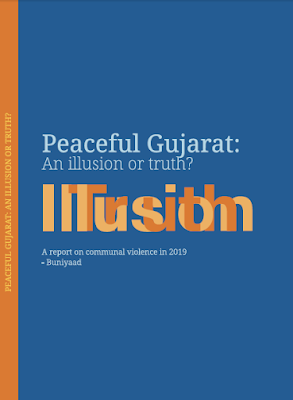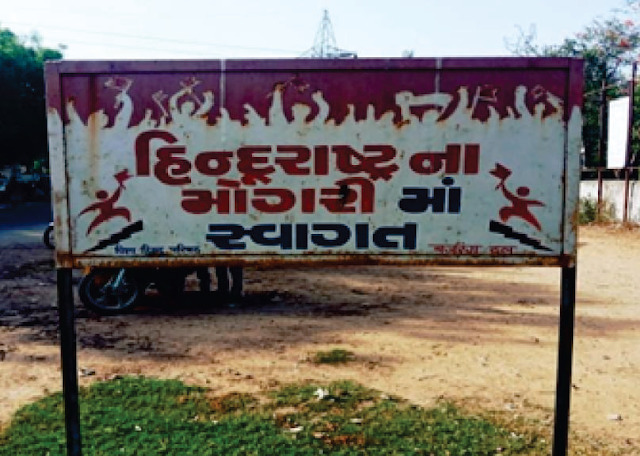By Rajiv Shah
Buniyaad, a Gujarat-based civil society organization, engaged in monitoring of communal violence in the state, in a new report, “Peaceful Gujarat: An Illusion or Truth?” has said that a “new trend” has come about in communal violence in the state, where the parts of Gujarat which didn’t see communal riots in 2002 are experiencing “regular bouts” of communal violence.
Pointing out that this new trend has become strong particularly after 2014, when Narendra Modi took over the reins of power in Delhi, the report says, “Also, the theatre of violence has changed from urban Gujarat to rural Gujarat. Earlier, Ahmedabad, Vadodara and Surat, the bigger cities of Gujarat, witnessed major communal riots in 1946, 1969, 1981-82, 1985, 1990, 1992, 2002, and 2006.”
However, “Post-2002 riots, places like Chhatral, Vadali, Khambhat, Himmatnagar, Idar, Kheda and Halwad are witnessing communal riots”, adding, “In 2019, out of total six incidents, five incidents took place in small towns, blocks and villages, including Khambhat, Kotda Gadi village of Sabarkantha district, Nandoliya village of of Kadi taluka, Dhunadara village of Kheda district.”
According to the report, “Khambhat, a coastal town in Anand district, has over the years emerged as a hotbed of communal conflicts. In February 2020, the simmering tensions brewing in Khambhat culminated in the communal riots on February 23. A few days before February 23, an area called Bhavsarwad inhabited mostly by affluent Hindus was looted.”
It adds, “This looting was seen as an opportunity for polarizing and also spreading hatred by dominant group, Hindu Jagran Manch, which organized a rally where aggressive slogans were raised. Khambhat BJP leader and former MLA, Sanjay Patel and Khambhat city unit head of BJP, Pinakin Brahmbhatt, allegedly raised religious slogans. The slogans in the rally were exhorting Hindus to oust Muslims from the town.”
According to the report, “Khambhat has emerged as a site for communal riots since long. In February 2012, a dispute over construction of shops on the land under the Waqf Board between Muslim and Chunara community at Akabarpur resulted in large-scale riots. The mob used stones, acid bulbs, and petrol bombs to attack which left six houses charred.”
“Subsequently”, the report asserts, “In November 2016, after a minor accident of a Muslim tempo driver which collided with a bike ridden by a person from Ravad community in Pith Bazar area of Khambhat communal clashes took place. This morphed into a riot where both the communities pelted stones at each other.”
It adds, “The flames of this riot spread to Rana Chakla, Madai, Vansdavad areas of Khambhat. The mob targeted houses belonging to Muslims, one temple, one Masjid, Dargah, and five shops belonging to Muslims and one belonging to a Hindu, were set on fire. Four persons were injured in the clash – one belonged to Muslim community who was badly injured and three police personnel. In 2017 and 2018 sporadic incidents and provocation continued to occur in Khambhat.”
According to the report, “The clashes in Khambhat were preceded by another communal riot on February 22, 2019. Two groups clashed in the Teen Darwaza area of Khambhat over a social media post on Pulwama attack. Tension began two days before due to arguments over a social media post over compensation to be given to the martyrs of the terror attack in Pulwama in February 2019. This led to stone pelting between, members of both the communities resulting into riots.”
“In fact”, the report asserts, “So intense is the attempt to polarize communities along religious lines, that the state has imposed the Disturbed Areas Act in the town”, claiming, “This law in effect is strengthening the process of ghettoization on religious lines by disallowing sale of property to persons of other religious communities without the prior permission of the authorities.”
Then, the report says, in 2019, Gujarat witness two riots out of six because of love jihad. In Kotda Gadi village in Sabarkantha district, a minor Adivasi girl and a Muslim boy were found to be in relationship for a long time. Both left the village, but after some time the girl returned and a compromise was worked out. 2002 riots were on large scale in terms of its geographical expanse and losses. Thereafter small scale riots led to rapid polarizationIt adds, “An agreement was signed whereby the boy would not return to village and an amount of Rs 35,000 would be paid as compensation to the girl’s family as settlement amount. But after a few days, the couple fled the village again. A mob from Adivasi community attacked the Muslim locality causing up to 12 Muslim families to flee from the village.”
In yet another incident, on May 15 in Dhunadra village in Thasra taluka of Kheda district, a riot took place over the marriage procession of a non-Muslim girl which was accompanied with a music band and lighting of crackers. “When the procession reached near a mosque in the village, some members of the Muslim community in the locality asked the procession to stop the music and the burning of fire crackers. This event led to a confrontation and violence.”
In Mehsana district, communal tension was stoked by reports of “love jihad” spread through social and electronic media. The report asserts, “In a local college, one Muslim boy and Hindu girl were in a relationship. They were confronted by one Dhaval Barot a Vishwa Hindu Parishad (VHP) member, who threatened the couple.”

Following this, “some boys beat up Dhaval Barot and he was injured. Dhaval Barot used this incident of so called love jihad to defame the Muslim youth and claimed that he was protecting the Hindu women from jihadists. The media aided him and portraying Dhaval Barot as a victim, changed his name to Dhaval Brahmbhatt to protect his identity.”
In another, following the Supreme Court order clearing the way for the construction of the Ram Mandir at the Babri Masjid site, “There were claims from different parts of the country of some mosques being built on the ruins of Hindu temples and attempts to reclaim the same. The same claim came up in Dholka, Ahmedabad.”
“Tanka Masjid situated in Dholka was established in 1361.Some anti-social elements spread rumours and claims that the Masjid was earlier a temple and was forcefully occupied and built as a Masjid. This narrative created communal frenzies in the area. Anti-social elements tried to visit the Masjid on August 29 and 30, 2019 to create tensions and to give message of occupying the same. After intervention by a civil society group in the issue, police provided protection to the monument. Due to this a big communal violence has prevented.”
Then, there was an incident in Sehra town of Panchmahal district. “In July, a rally was organized by under the banner of Hindu Samaj which demanded that a missing Hindu woman who is a victim of love jihad be traced. A bandh was called by Hindu organizations after a Hindu woman went to Ahmedabad with her parents for her mother’s medical treatment. But the Hindu organizations portrayed this as an incident of love jihad.”
The incidents suggest that “the nature of communal violence has changed after the 2002 communal carnage”, the report claims, adding, While the 2002 riots “were on a large scale in terms of its geographical expanse and losses in terms of property and lives, subsequent riots are sub-radar on a smaller scale.” The recurrence of “small scale riots” has led to “rapid polarization of the society along religious lines”, it adds.

Leave a Reply